Understanding human behavior is central to effective management and leadership. In this context, Transactional Analysis (TA) emerges as a powerful psychological framework that helps individuals and teams analyze interactions and improve relationships. Developed by psychiatrist Eric Berne in the 1950s, TA focuses on communication patterns and ego states to understand how people relate to each other.
Introduction to Transactional Analysis
Transactional Analysis (TA) is a psychoanalytic theory and method of therapy wherein social transactions are analyzed to determine the ego state of the communicator as a basis for understanding behavior. It assumes that every individual has three ego states: Parent, Adult, and Child.
Key Points:
- TA is both a theory of personality and a systematic psychotherapy for personal growth.
- It helps in understanding how people communicate and why conflicts occur.
- TA identifies patterns in conversations that reveal deeper emotional processes.
- Widely used in management, coaching, education, and counseling.
TA enables better interpersonal communication and self-awareness by dissecting interactions into recognizable patterns, allowing for healthier and more effective relationships.
The Three Ego States in Transactional Analysis
At the core of TA are three distinct ego states that influence how individuals behave, think, and feel during interactions.
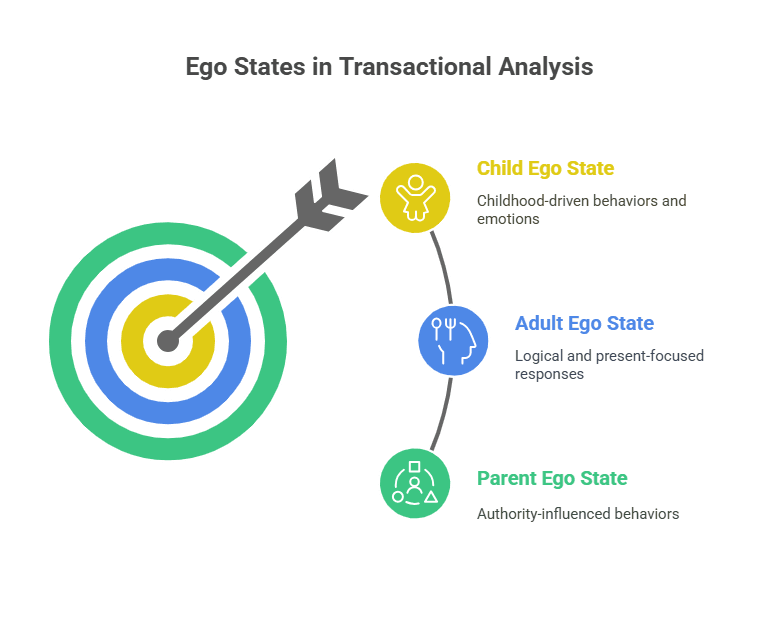
Key Ego States:
- Parent Ego State: Behaviors, thoughts, and feelings copied from parental figures or authority.
- Adult Ego State: Behaviors that are direct responses to the present, logical, and data-driven.
- Child Ego State: Behaviors replayed from childhood—includes natural responses like curiosity or rebellion.
Further Divisions:
- Parent: Nurturing Parent, Critical Parent
- Child: Free Child, Adapted Child
Highlights:
- Each ego state is equally important and activated depending on the situation.
- Understanding ego states helps predict how people will behave in certain contexts.
- Individuals can shift between ego states during a single conversation.
Recognizing these states is key to navigating and improving interpersonal dynamics.
Types of Transactions in Transactional Analysis
Transactions are the fundamental units of communication in TA, consisting of stimulus and response between two or more people.
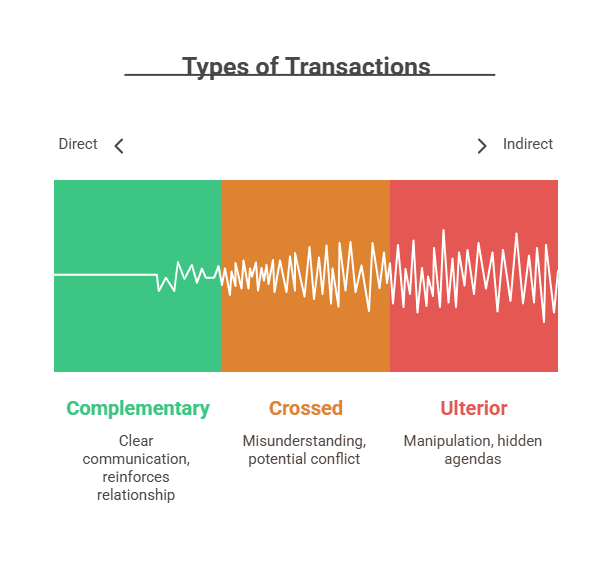
Types of Transactions:
- Complementary Transactions: Responses occur between expected ego states (e.g., Adult to Adult).
- Crossed Transactions: The response comes from an unexpected ego state, leading to conflict or confusion (e.g., Adult to Child, but response comes from Parent).
- Ulterior Transactions: There is a hidden or double message, often leading to manipulation.
Highlights:
- Complementary transactions enable smooth communication.
- Crossed transactions often cause conflict or misunderstanding.
- Ulterior transactions can damage trust in relationships.
Understanding these transactions helps manage conversations and resolve conflicts effectively.
Importance of Transactional Analysis in Interpersonal Relationships
TA is widely applied in both personal and professional settings to improve relationship quality, resolve conflicts, and enhance communication effectiveness.
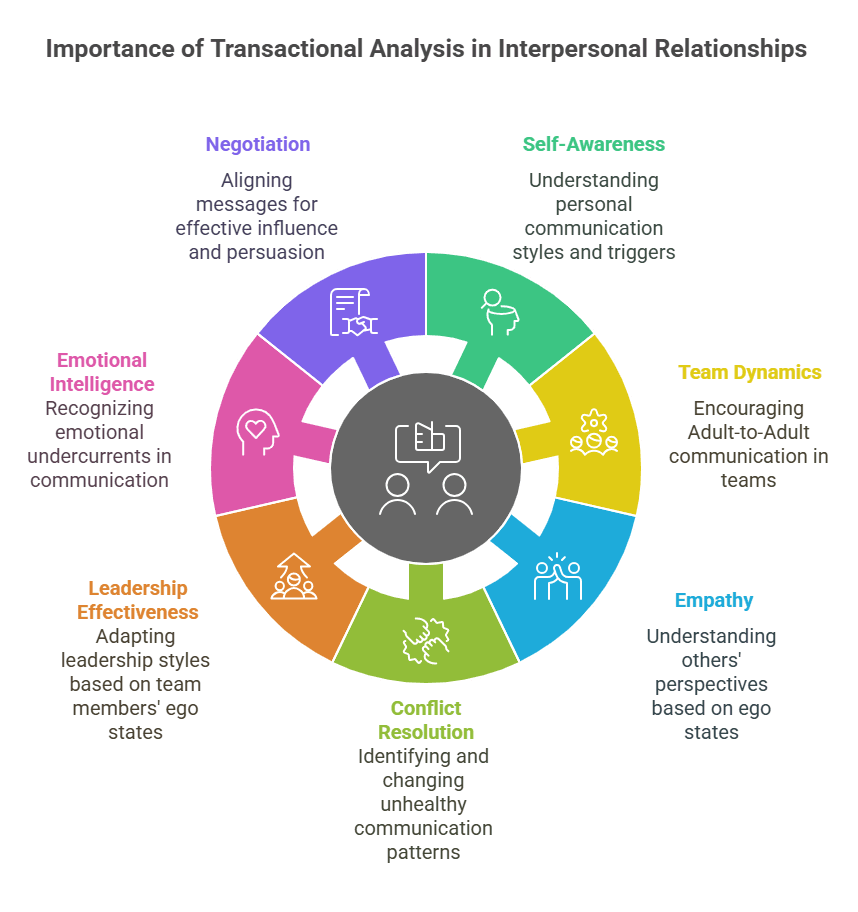
- Promotes Self-Awareness: Individuals understand their communication styles and triggers.
- Improves Team Dynamics: Encourages Adult-to-Adult communication.
- Builds Empathy: Helps understand others’ perspectives based on their ego states.
- Strengthens Conflict Resolution: Identifies unhealthy patterns and provides tools to change them.
- Enhances Leadership Effectiveness: Leaders can adapt their styles based on team members’ ego states.
- Encourages Emotional Intelligence: Recognizes emotional undercurrents in communication.
- Improves Negotiation: Helps align messages for effective influence and persuasion.
Transactional Analysis is a robust framework that can transform how people relate, lead, and collaborate.
Key Components of Transactional Analysis
The effective application of TA relies on a deep understanding of its core components, which guide the analysis and management of interpersonal exchanges.
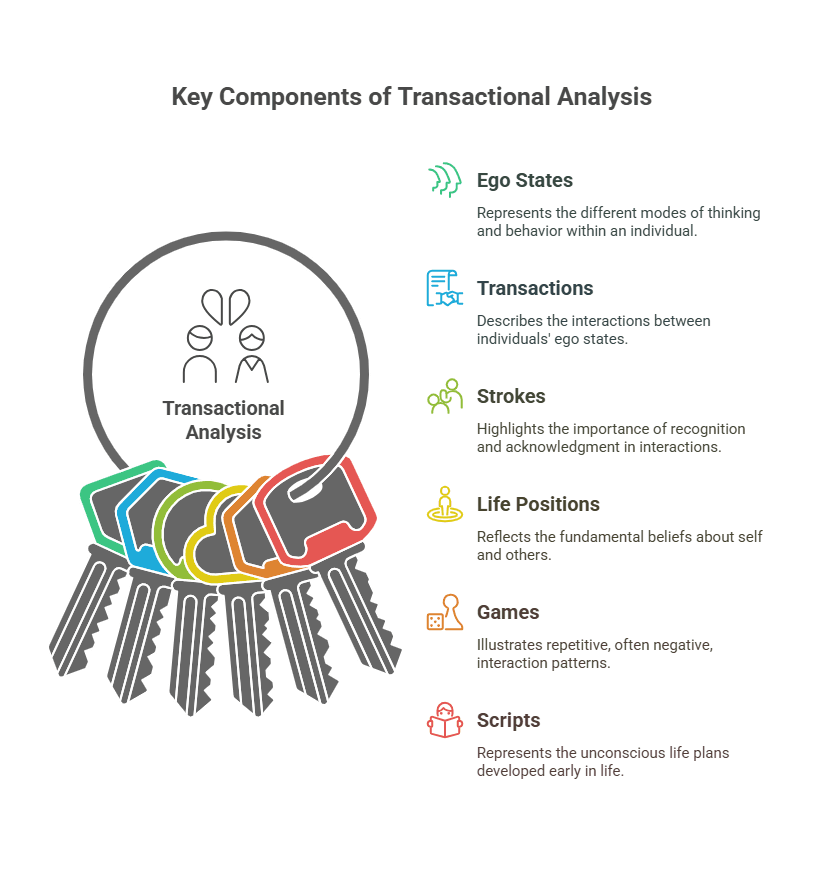
Core Components:
- Ego States: Parent, Adult, Child
- Transactions: Stimulus-response exchanges between ego states
- Strokes: Units of recognition that acknowledge another’s presence (e.g., compliments or criticism)
- Life Positions: Beliefs formed in early life such as “I’m OK, You’re OK”
- Games: Repetitive, covert interactions with predictable outcomes, often negative
- Scripts: Unconscious life plans developed in childhood
Highlights:
- Each component helps decode communication behaviors and emotional dynamics.
- Awareness of life positions and games helps break unhealthy relational patterns.
- Strokes and scripts affect motivation and self-esteem.
These components create a comprehensive lens through which to view and transform relationships.
Life Positions in Transactional Analysis
Life positions are deep-seated beliefs about oneself and others, developed during childhood, and are crucial in shaping interpersonal behavior.
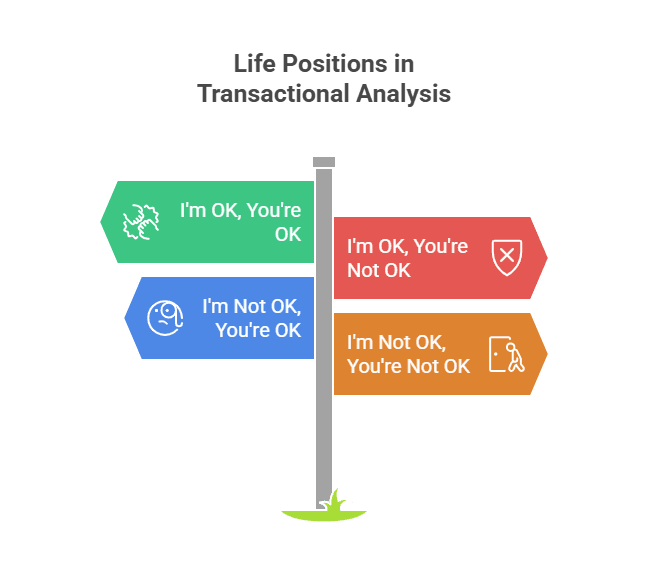
Main Life Positions:
- I’m OK, You’re OK – The healthiest position, fostering mutual respect.
- I’m OK, You’re Not OK – Defensive or superior stance.
- I’m Not OK, You’re OK – Low self-esteem or victim mentality.
- I’m Not OK, You’re Not OK – Hopeless, withdrawn attitude.
Key Points:
- These positions influence how individuals perceive others and handle conflict.
- Most effective managers operate from the “I’m OK, You’re OK” stance.
- Understanding life positions helps identify core beliefs and change negative patterns.
Promoting a healthy life position among team members is vital for building a respectful and trusting work culture.
Transactional Analysis in Conflict Resolution
Conflicts often stem from crossed or ulterior transactions. TA offers a structured way to identify and address the root causes of such conflicts.
Conflict Management through TA:
- Identifies ego states in play during disagreements.
- Encourages Adult-to-Adult interactions for rational problem-solving.
- Helps people step back from emotionally charged Child or Parent states.
- Teaches emotional detachment to view issues objectively.
Highlights:
- Resolves miscommunication by decoding the real intent behind words.
- Prevents escalation by avoiding reactive ego states.
- Encourages responsibility for one’s role in the conflict.
Transactional Analysis fosters a non-confrontational approach to managing workplace tensions.
Challenges in Applying Transactional Analysis
While TA is powerful, its application is not without limitations and difficulties, particularly in high-pressure environments.
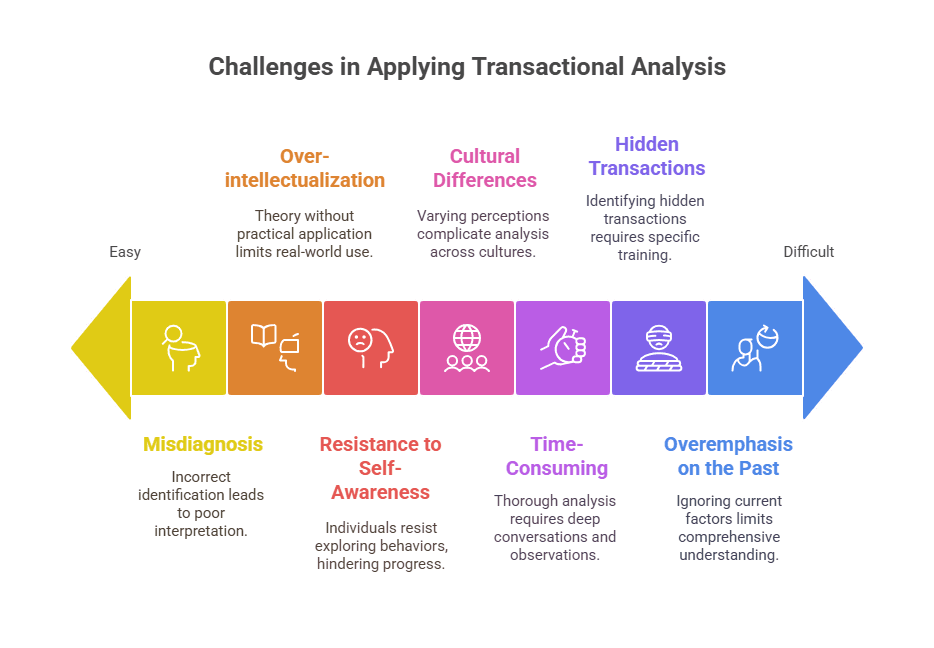
- Misdiagnosis of Ego States: Incorrect identification can lead to poor interpretation.
- Over-intellectualization: TA can become theoretical without practical application.
- Resistance to Self-Awareness: Some individuals may resist exploring their behaviors or beliefs.
- Cultural Differences: Perception of ego states and communication styles varies across cultures.
- Time-Consuming: Thorough TA analysis requires deep conversations and observations.
- Hidden Transactions: Difficult to identify without training.
- Overemphasis on the Past: May ignore current situational factors.
Awareness of these challenges allows managers to apply TA more mindfully and effectively.
Practical Strategies for Using TA in Team Environments
Transactional Analysis is not only theoretical—it can be integrated into daily business practices to enhance collaboration and communication.
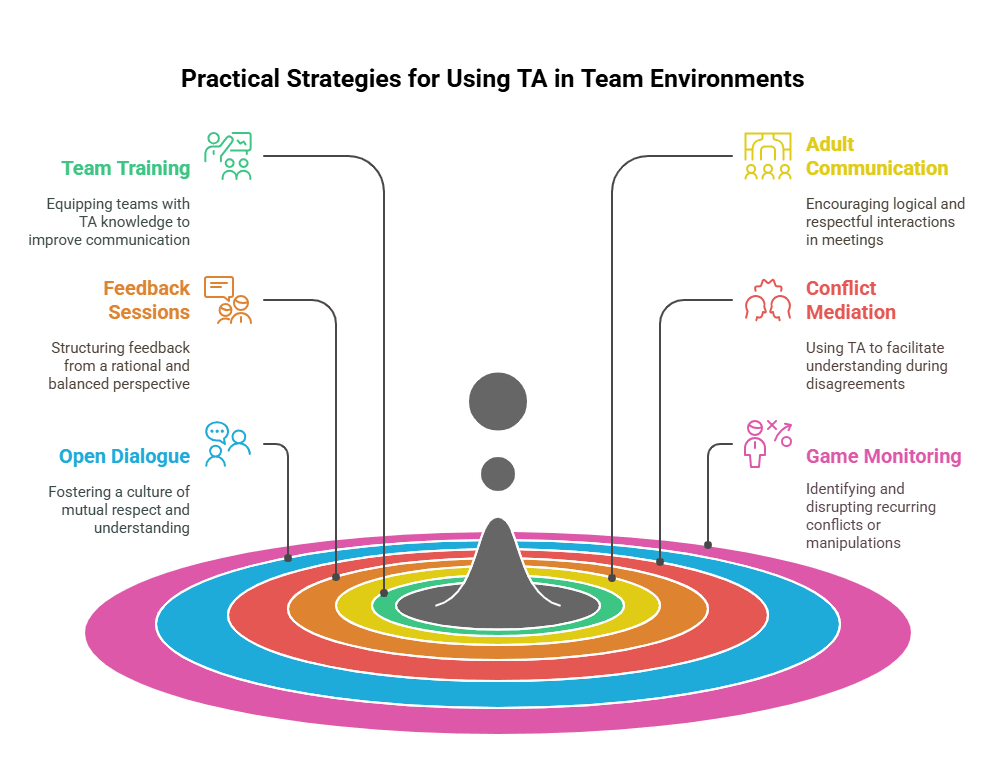
- Train Teams in Basic TA Concepts: Empower employees to recognize their communication patterns.
- Promote Adult-to-Adult Communication: Encourage logical, respectful exchanges in meetings.
- Use TA in Feedback Sessions: Structure feedback from the Adult ego state.
- Monitor Repeating Games: Identify and disrupt recurring conflicts or manipulations.
- Encourage Open Dialogue: Foster “I’m OK, You’re OK” thinking in team culture.
- Incorporate TA in Conflict Mediation: Use it to facilitate understanding during disagreements.
Consistent application of TA principles can shift team dynamics from conflict-prone to cooperative and solution-focused.
Real-World Examples of Transactional Analysis in Action
1. IBM’s Leadership Development Program
IBM incorporated TA into its executive coaching programs to help leaders understand their default communication patterns.
Key Takeaways:
- Leaders learned to shift from Parent or Child responses to Adult communication.
- Increased empathy and trust across departments.
2. Southwest Airlines’ Team Building
Southwest Airlines used TA-based training for flight crews to improve communication under stress.
Key Takeaways:
- Employees developed awareness of strokes and life positions.
- Team morale and customer satisfaction improved significantly.
3. Pfizer’s Cross-Cultural Negotiations
In a cross-border negotiation training program, Pfizer taught TA to reduce misunderstandings between international teams.
Key Takeaways:
- Improved mutual respect through the Adult ego state.
- Helped negotiators decode hidden messages and resolve stalled deals.
4. Google’s Conflict Resolution Initiatives
Google implemented elements of TA in resolving team conflicts and enhancing collaboration in its product design units.
Key Takeaways:
- Reduced recurrence of interpersonal games.
- Enhanced focus on productive, Adult-level dialogue.
These cases highlight the versatility of Transactional Analysis in enhancing communication, leadership, and cooperation in diverse organizational contexts.
TA in Leadership and Managerial Effectiveness
TA is an essential leadership tool for improving communication, decision-making, and emotional management.
- Develops Emotional Intelligence: Helps leaders manage their own reactions and understand team members.
- Enhances Coaching Skills: Assists in guiding employees without judgment (Adult-to-Adult).
- Builds Trust: Transparent and rational interactions reduce fear and politics.
- Strengthens Influence: Understanding others’ ego states improves persuasion.
- Supports Change Management: Addresses psychological resistance through better communication.
Effective leaders use TA to cultivate a positive and high-performing team environment.
For More Content Check Out :- BMB 101
Conclusion
Transactional Analysis is more than a psychological theory; it is a powerful tool for understanding, managing, and transforming interpersonal relationships in professional settings. By recognizing ego states, decoding transactions, and fostering Adult-to-Adult communication, individuals and teams can resolve conflicts, build trust, and improve collaboration. For MBA students and aspiring leaders, mastering TA equips them with a strategic advantage in navigating the complexities of human interaction in today’s organizations. As businesses become more collaborative and people-centric, Transactional Analysis offers a framework not just for communication—but for true connection.Transactional Analysis Tool for Understanding Interpersonal Relationships

